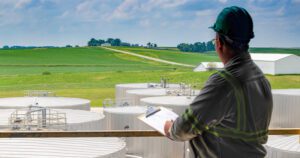Corporate sustainability commitments are shaping the future of clean fuels and may be the catalyst that takes our industry to the stratosphere. Studies show that a company’s green practices increase consumer trust, word-of-mouth recommendations, credibility, satisfaction, loyalty, perceptions of value, and purchasing decisions. Consumers want to feel better about their purchasing decisions. They want to do business with companies that share their environmental goals, and decision makers at some of the United States’ largest companies are responding.
The 2023 Energy Transition Outlook Survey Report, which surveys investors and CEOs of many major corporations, shows that 64% of investors and 54% of executives say their plans have shifted even more toward renewables in the past year.
Amazon is committed to 50% of its shipments being net zero carbon by 2030. Walmart’s goal is zero emissions across all of its global operations by 2040. Microsoft says it will be carbon negative by 2030 and will take steps to remove the equivalent of all the carbon the company has emitted since its formation in 1975.
With many companies committing to a carbon-neutral future, low carbon transportation fuels will be vital to reaching their goals, which trickles down to their transportation partners and product suppliers. Any fleet over land, sea or sky will need low carbon options if they want to do business with the biggest retailers in the world.
Cutting emissions is critical for companies that want to stay in business over the next decade, but it isn’t simply a good business practice, it’s the right thing to do.
In 2022, Trinity Consultants released the second phase of our multi-year study, which examined 15 high-risk air quality communities across the United States. It models the health improvements those communities could experience by replacing diesel fuel with B100. The results show an astounding decrease in cancer risk, fewer premature deaths, reduced asthma and other significant health impacts.
Numbers matter. They help us quantify an issue, but sometimes when we’re staring at numbers, we lose sight of the real people affected.
Recently, I read an interview with a woman named Lisa Loflin, who was six years old when construction on the Capital Beltway in Washington, D.C. began. She described traffic noise that kept the family inside, nightmares from frequent car crashes, increased crime and community ties that were severed by the highway. She also discussed the soot that killed their garden and coated the back of their house. “When you look at the house,” she said, “you can see what it’s doing to your lungs.”
What Lisa suspected while observing the residue buildup on the walls of her family home has now been backed by science. And the health risks may be even worse than she expected.
In many ways, the Interstate Highway System is a miracle, a work of ingenuity and ambitious in scale. It connected the country in ways previously unimagined and offered Americans new opportunities. But, as it connected the country, it literally divided many communities. While highways previously tended to go around cities, the Interstate Highway System was designed to take the main line through the populated areas it connected, uniting the urban core and the suburbs. Millions of people were suddenly living along an increasingly busy interstate, disproportionately affecting communities of color.
Jefferson City, my hometown, has little in common with the major metropolitan areas analyzed in the Trinity study, yet Missouri’s capital wasn’t exempt from the trends of the times. The Rex Whitton Expressway, named after one of the pioneers of the Interstate Highway System, spans Jefferson City. When it was built over 60 years ago, it cut through The Foot, a community that sprung up around the turn of the 20th century at the foot of the hill near the historically black college Lincoln University. It was a thriving neighborhood with businesses and storefronts, places of worship, a pool and a community center, until the highway was built. Many of these establishments were bought and either bulldozed to make way for the highway or sold off for other renovation projects, while others were left with a highway in their backyards. They faced plummeting home values, intrusive traffic noise, and as we now understand, substantial health risks.
No one should have to wait for cleaner air, not when we can make a difference today. Carbon emissions show us how one person’s actions affect so many others. Clean fuels can’t solve all of these problems, but they can make a substantial improvement. Clean fuels are the one way for fleets to slash emissions overnight. Our fuels are the one sustainable way to power heavy-duty vehicles over land, sea and sky.
Consumers are demanding greener practices, and companies can see where the road is heading. Clean fuels are not a dream for a sustainable future. We’re here now.
ABOUT CLEAN FUELS ALLIANCE AMERICA
Made from an increasingly diverse mix of resources such as recycled cooking oil, soybean oil, and animal fats, the clean fuels industry is a proven, integral part of America’s clean energy future. Clean Fuels Alliance America is the U.S. trade association representing the entire biodiesel, renewable diesel and sustainable aviation fuel supply chain, including producers, feedstock suppliers and fuel distributors. Clean Fuels receives funding from a broad mix of private companies and associations, including the United Soybean Board and state checkoff organizations.




